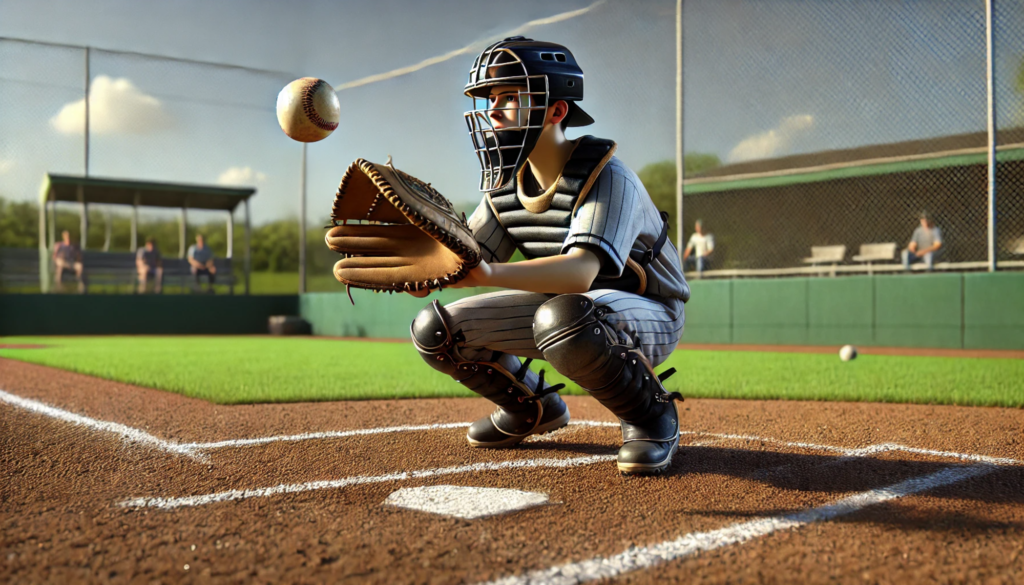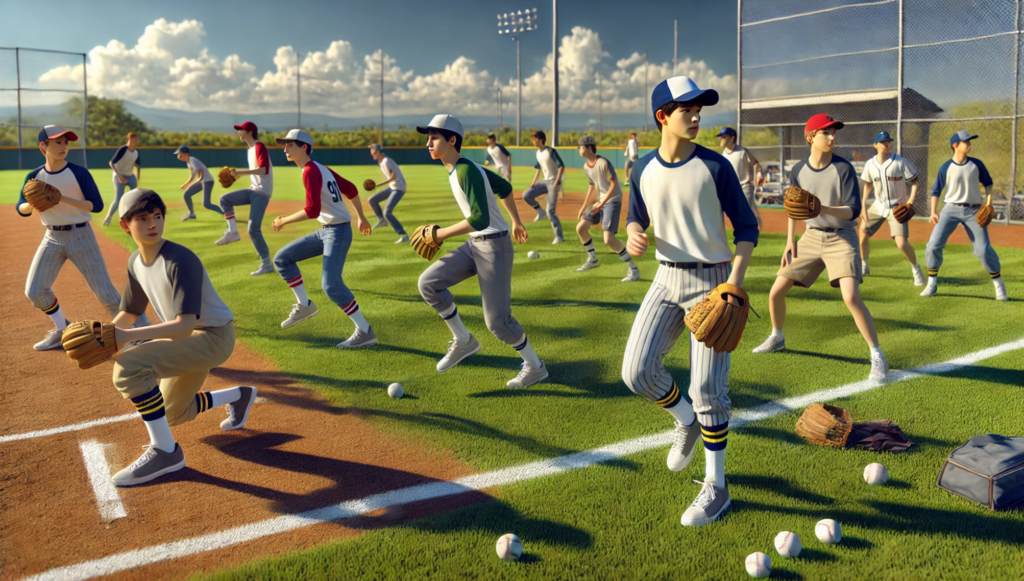Baseball is a game played between two teams, where the goal is to score runs by hitting a pitched ball and running around a series of bases to reach home plate. Understanding the basic rules, positions, and objectives is the first step for any young player.

Equipment Essentials
For young baseball players, having the right equipment is crucial. Here’s a list of essentials:
- Glove: Ensure it fits the player’s hand comfortably.
- Bat: Choose a bat appropriate for the player’s age and size.
- Helmet: Safety first – a properly fitting helmet is mandatory.
- Cleats: Provide good grip on the field.
- Uniform: Comfortable and appropriate for the weather conditions.
- Protective Gear: Includes a cup, shin guards, and a chest protector if necessary.
Safety First
Emphasizing safety can prevent injuries and ensure a positive experience. Key safety tips include:
- Always warm up before playing.
- Use proper equipment.
- Follow the coach’s instructions.
- Stay hydrated and take breaks when needed.
- Learn proper techniques to avoid strains and sprains.
Fundamental Skills Development
Throwing Techniques
Throwing is a fundamental skill in baseball. Young players should focus on:
- Grip: Hold the ball with a four-seam grip.
- Stance: Stand with feet shoulder-width apart, knees slightly bent.
- Throwing Motion: Use a smooth, overhand motion, following through after release.

Catching Skills

Catching the ball efficiently is crucial. Tips include:
- Glove Position: Keep the glove open, fingers pointing up for high balls and down for grounders.
- Body Position: Stay balanced, with knees slightly bent.
- Soft Hands: Absorb the ball into the glove gently to secure it.
Hitting Basics

Hitting requires coordination and timing. Focus on:
- Stance: Feet shoulder-width apart, knees slightly bent, weight balanced.
- Grip: Hold the bat firmly but not too tight.
- Swing: Start the swing from the legs and hips, follow through with the arms.
Fielding Fundamentals
Infield Techniques
Infielders need quick reflexes and good footwork. Key tips:
- Ready Position: Stay low with knees bent, weight on the balls of the feet.
- Fielding Ground Balls: Move towards the ball, scoop it with the glove, and throw quickly.
- Double Plays: Practice quick exchanges from glove to hand.

Outfield Skills
Outfielders cover a lot of ground and need strong throwing arms. Focus on:
- Tracking the Ball: Keep eyes on the ball, adjust position as needed.
- Catching Fly Balls: Use both hands to secure the catch.
- Throwing: Use a crow hop to add power to the throw.

Base Running and Stealing
Running the bases effectively can turn hits into runs. Tips include:
- Speed and Agility: Practice sprinting and quick changes of direction.
- Sliding: Learn proper sliding techniques to avoid injuries.
- Stealing Bases: Develop quick starts and good timing.
Building Physical Fitness
Strength and Conditioning
Strength and conditioning improve overall performance. Key exercises:
- Core Strength: Planks, sit-ups, and other core exercises.
- Leg Strength: Squats, lunges, and leg presses.
- Upper Body: Push-ups, pull-ups, and arm exercises.

Flexibility and Agility
Flexibility and agility help prevent injuries and improve performance. Include:
- Stretching: Regular stretching routines for all major muscle groups.
- Agility Drills: Ladder drills, cone drills, and other agility exercises.
Injury Prevention
Preventing injuries ensures continuous improvement. Tips include:
- Proper Warm-Up: Always warm up before playing or practicing.
- Cool Down: Cool down and stretch after activities.
- Listen to Your Body: Rest if you feel pain or discomfort.
Mental Preparation
Focus and Concentration
Staying focused is key to success in baseball. Techniques include:
- Visualization: Imagine successful plays before they happen.
- Mindfulness: Practice staying present and calm during games.
Game Strategy Understanding
Understanding game strategy enhances performance. Learn about:
- Situational Awareness: Know what to do in different game situations.
- Team Strategy: Understand the team’s game plan and your role in it.
Building Confidence
Confidence comes from practice and positive reinforcement. Tips include:
- Positive Self-Talk: Encourage yourself with positive thoughts.
- Celebrate Successes: Recognize and celebrate small achievements.
Practice and Drills
Effective Practice Routines
Consistency is key to improvement. Establish routines that include:
- Warm-Up: Always start with a warm-up.
- Skill Drills: Focus on different skills each practice session.
- Cool Down: End with a cool-down and stretching.
Drills for Skill Improvement
Incorporate various drills to improve skills:
- Throwing Drills: Practice accuracy and distance.
- Catching Drills: Focus on different types of catches.
- Hitting Drills: Work on swing mechanics and timing.
Importance of Consistent Practice
Regular practice helps solidify skills and build muscle memory. Ensure:
- Routine: Stick to a regular practice schedule.
- Variety: Mix up drills to keep practice engaging.
- Goal Setting: Set specific goals for each practice.

Teamwork and Sportsmanship
Playing as a Team
Baseball is a team sport, and teamwork is crucial. Encourage:
- Communication: Talk to teammates during the game.
- Support: Encourage and support each other.
- Role Understanding: Know your role and contribute to the team effort.
Respecting Teammates and Opponents
Sportsmanship is vital in baseball. Teach:
- Respect: Show respect to teammates, coaches, and opponents.
- Fair Play: Play by the rules and accept outcomes gracefully.
- Positive Attitude: Maintain a positive attitude, win or lose.
Developing a Positive Attitude
A positive attitude can enhance performance and enjoyment. Focus on:
- Encouragement: Encourage yourself and others.
- Perseverance: Keep trying, even when things are tough.
- Enjoyment: Remember to have fun and enjoy the game.
Fun and Motivation
Keeping Training Enjoyable
Enjoyment keeps young players motivated. Tips include:
- Variety: Mix up drills and activities.
- Games: Incorporate fun games into practice.
- Rewards: Use rewards and recognition to motivate.
Setting Goals and Celebrating Achievements
Goal setting helps track progress. Encourage:
- Short-Term Goals: Set achievable goals for each practice.
- Long-Term Goals: Aim for bigger achievements over the season.
- Celebrate: Celebrate milestones and successes.
Encouraging a Love for the Game
Fostering a love for baseball ensures long-term participation. Tips include:
- Role Models: Share stories of famous players.
- Watch Games: Watch professional games together.
- Family Involvement: Encourage family support and involvement.
Training young baseball players is about more than just developing skills; it’s about instilling a love for the game, teaching valuable life lessons, and ensuring they have fun along the way. By focusing on fundamental skills, physical fitness, mental preparation, and fostering a positive and enjoyable training environment, young athletes can thrive both on and off the field. Remember, the journey is just as important as the destination, and with the right guidance and support, young players can enjoy every step of their baseball adventure.



